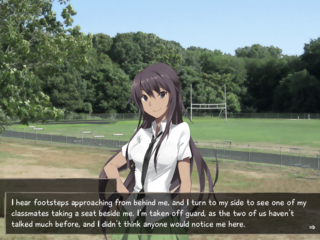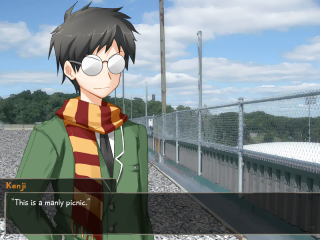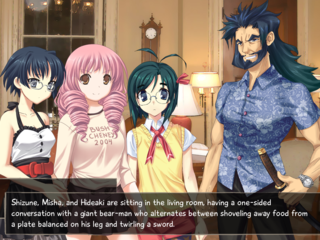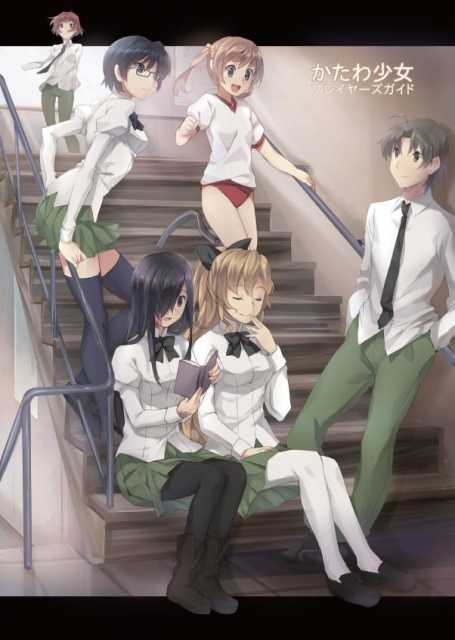A thoughtfully developed and incredibly well executed experience.
Sex and video games rarely mix, at least in a meaningful way. Although many video games feature sex as some aspect of their narrative, these scenes rarely contribute much to the overall story; instead, they are often times given out as a juvenile award, of sorts. However, recent visual novel Katawa Shoujo (Japanese for “Disability Girls”) manages to avoid this. Although rough along the edges, Katawa Shoujo manages to show the utmost respect both for its themes and sexual content, creating a memorable, gratifying experience in the process.
Unfortunately, it takes a while to reach this point. The game begins with high school student Hisao Nakai having a heart attack and finding out that he has a heart defect. Because of this, he is forced to transfer to Yamaku High School, a school designed to accommodate disabled students. During his first few days at Yamaku, however, the plot does not move very much. While the game makes it a priority to introduce all the girls available to date throughout the game as soon as possible, nothing happens during this introductory phase; Hisao simply does schoolwork, makes small talk with many of the girls at Yamaku, and tries a few extracurricular activities. Because of the divergent storylines, it takes some time before significant plot development occurs. Between the beginning and that point, though, it becomes easy to notice some patterns regarding the narration. For example, it can change a lot between realistic dialogue and novelistic wording. Although it is, by definition, a novel, every line is narrated by the protagonist, essentially making it all dialogue. This means that while the narrative can fill in many details that the visual aspects cannot, it can also come across as unnatural. However, this does not mean that the narrative is especially bad at doing its job; in fact, important events and Hisao’s thoughts are incredibly clear and easy to understand. It is just somewhat rough and could be more consistent.

Perhaps it is because Hisao’s thoughts are so clear to the audience that he comes across as a very hard character to like. Part of this is because of how intrusive and predatorial Hisao is. It starts off innocently enough with Hisao hanging out with a couple of the girls (no matter the route, the female students of Yamaku always come in pairs) simply because he has nothing better to do. Yet as the story progresses, he becomes more invasive regarding their emotional problems. When he notices something amiss about a girl’s personality or back story, he will forcefully press the issue, much to the chagrin of those involved. This may have been intended to come off as Hisao genuinely caring about their well being, but the scenarios often contradict this notion; the potential love interests experience clear emotional pain when subjected to his prying behavior, but more often than not, he refuses to back off. Should a girl rightfully decline to open up about their emotional problems, Hisao simply reacts with anger. This is particularly bad in Emi and Rin’s routes; Emi repeatedly makes it clear that she does not want to open up, and Rin has noticeable difficulty putting her thoughts and feelings into words.
Another reason why Hisao is so unlikable is how hard it is for him to get past the various disabilities presented to him in his school experiences. Whenever he first meets a girl, he immediately takes notice of their disability and begins to wonder how he should act around them because of it. Although this is meant to portray him as socially careful and adjusting to his new life at Yamaku, it often comes across as insensitive and treating the girls differently specifically because of their disabilities. In fact, several characters essentially end up telling him that a person’s disability does not make them think differently from people without disabilities. Despite this, it takes Hisao a long time to get over any given girl’s disability (even though this is very easy to do as the player). For example, he spends much of his time with Lilly surprised at how little her blindness actually handicaps her. Similarly, in his interactions with his shy classmate Hanako, Hisao constantly dances around the subject of how to deal with her burns, even though her personality makes it obvious that she would be more comfortable if this aspect about her were not brought up. This becomes especially bad when he begins treating whichever girl he’s dating as somebody who needs to be protected or fixed of their problems, even if the girls themselves are not receptive of this attitude. This often happens late in a girl’s route, long after he has come to know them on a deeply personal level, giving off the impression that he still does not see them as actual people.

Despite all this, Katawa Shoujo manages to succeed largely because of its well developed cast of characters. From the very beginning, the game sets out to craft a great ensemble of characters, from the quirky, crass, yet likable Kenji to the confrontational Shizune. What makes it remarkable, however, is just how much it develops these characters. Although serious characterization is often limited solely to a character’s own route (except developer favorite Hanako, who grows as a person in Lilly’s route, as well), this is more than made up for by the sheer scale of character development present in each character. Through some perfect combination of dark moments and proper respect for its own themes, the game successfully depicts the characters as actual people who are easy to sympathize with and develop emotions for. While this is a good quality in and of itself, it also contributes immensely to the story thematically. Not only does this attention to detail make the events as emotionally powerful as they are, but it also directly demonstrates that the characters are real people who are not to be defined solely through their disabilities or even the emotional problems that often become the focus of the story. Simply put, it is difficult to find characters in other video games this incredibly well written.
In fact, the various characters are written so well that potential emotional developments could interfere with other aspects of the game. For example, Katawa Shoujo’s very nature as a video game can make both Hisao and the player insensitive through no fault of their own. Once a route is done, there is nothing left but to move onto another girl. This amounts to little more than abandoning your previous love interest and leaving them with their problems. Although their problems are not addressed (as the majority of a character’s development happens exclusively within their route), one would have to be willfully ignorant to ignore them, since certain important events (such as Emi’s race and Hanako’s birthday) overlap between routes. Worse yet, getting some of the bonus materials requires achieving 100% completion, which will inevitably mean earning a purposefully bad ending that furthers a girl’s problems.

In addition, because of how well the various girls are characterized, the inevitable sex scenes in each route are difficult to enjoy, no matter how well executed they are. Because of the deep emotional connections you will inevitably develop over the course of the game, watching characters have sex often feels like spying on two good friends have sex: awkward, intrusive, and hard to enjoy. This is not to say that the sex is poor. In fact, this is handled with as much tact and respect as the rest of the game. While nudity is (very obviously) present, Katawa Shoujo does not make a spectacle of it. Instead, the game tends to show only what’s necessary for a given scene and showing the utmost respect. Things only improve from a plot perspective, as each sex scene actually serves an important purpose in the storyline. Whether it strengthens somebody’s characterization (such as in Emi’s route) or moves the plot in an important direction (as in Hanako’s route), it is obvious that some level of thought was put into these portions of the game. There is really only one sex scene that comes off as abrupt and obligatory, but since this sex scene leads to a bad ending (IE one the developers do not ideally want the players experiencing), it is hard to hold it against the game. However, it is because of the overall effectiveness of the story that it is as hard as it is to see the sexual parts of the game as very arousing (especially given how late they appear in each route).
Yet another reason behind the story’s effectiveness is in its visuals, which, while as conflicted as the narrative, still manage to do an admirable job of portraying the story. Although each route begins with a brief video cinematic, the vast majority of the plot is told through anime portraits on semi-realistic backgrounds. While this may sound limiting (and, to some extent, it can be), Katawa Shoujo puts this aspect of itself to the fullest use possible. Characters can fidget, bounce up and down, lean in, and generally display a startlingly wide range of actions. This does much for the experience, turning potentially static characters into lively, energetic beings. When combined with the narrative, it really helps to bring the characters to life, especially given the lack of overlap between the two portions of the game. The only significant complaint against the visuals stems from the backgrounds, which do not blend well with the anime portraits. Instead, they seem to be pictures of real life areas with basic Photoshop filters applied, which can be somewhat jarring when placed against the cast of the game. While it is not difficult to adjust to this artistic choice (partly because of how reluctant the game is to introduce new locations), it can still come across as inconsistent and strange.
Visual novels have, for a very long time, been considered a niche genre by many. Whether because of the general lack of interactivity in many of them or associations with more sexual aspects, visual novels have not enjoyed the mainstream success that many other video game genres have enjoyed over the years. Fortunately, Katawa Shoujo appears to be changing this situation (even if only for the time being), and for very good reason. Through careful use of both visual and written narrative, Katawa Shoujo is able to craft incredibly realistic characters, making for one of the more emotionally captivating games in recent memory.

0 Comments